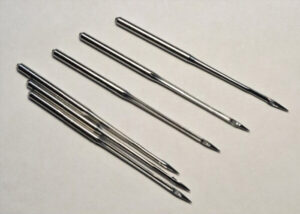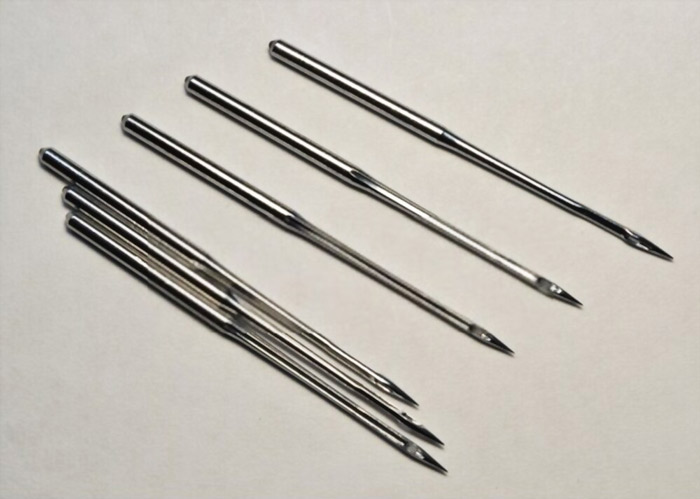One of the beautiful things about sewing is that there are so much versatility and variety.
 With that in mind, it’s safe to say that you’re always on a journey to learn more, and there’s still no shortage of experience.
With that in mind, it’s safe to say that you’re always on a journey to learn more, and there’s still no shortage of experience.
A single component that stands out when it comes to sewing machines is their needle.
Coming in a multitude of shapes and sizes, it’s obvious that they might function differently.
Don’t worry; you don’t need to know all of them. But as a safety measure, I’ll take you over them briefly.
Let’s get right into it!
1. Universal Needle
The first type of needles that I’d like to highlight, arguably the most prevalent ones out there, are universal needles.
Uses: The best thing about them is that they can virtually be used for any sewing application, making life more comfortable.
However, as a side note, I’d recommend that you get something more specialized if you’re working on ultra-light or heavier fabrics.
On the other hand, if you’re working on woven fabric, this is the best type to go with.
2. Ballpoint Needle
Ballpoint needles are very similar to universal needles and are often confused. However, there’s the main difference that you should watch out for.
In this needle type, you should anticipate rounded edges and that it shouldn’t be tapered either, unlike the universal needle.
Uses: Their application and use are virtually the same as the one above and can easily handle all tasks with ease. However, the advice stays the same – for the specialized task, get something more solution-oriented.
3. Wing Needle
Wing needles also referred to as hemstitch needles, are called so because they have a distinct flange at their sides, which gives it the appearance of having wings.
Uses: The primary purpose that they’re for is for decorating and is highly optimized for niche tasks.
The general rule of thumb to remember is that the bigger the size of the needle, the bigger the hole will be. So make sure you know the pattern you’re after and then choose the size appropriately.
4. Metallic Needle
Metallic needle, quite counter-intuitively, isn’t called what they’re called because of their construction or durability. Their defining feature is their large eye.
Uses: The primary purpose that metallic needle serves is to easily accommodate heavier threads, which can make the whole sewing process easier.
Furthermore, they’re also noted for shred-free or split-free work, so they’re a good choice for precision or heavy-duty work.
5. Self-Threading Needle
Self-threading needles have a particular slot that allows easy threading. This is a great choice if you’re a beginner and are just getting into the world of sewing.
Uses: I’d highly vouch for it if you have trouble threading and want something that will save you both time and energy.
This is because they have a small slot on one side that you can use to slide the thread in, and then you’re effectively good to go.
6. Sharp Needle
Sharp needles, true to their name, are the sharpest type of sewing needle on this list and should be carefully handled. They are also sharper than the universal variety and feature a shaft that is slenderer and precise.
Uses: The primary purpose of this type of needle is to carefully work on fine woven and fine fabrics.
Furthermore, they’re also a great choice if you want something for piercing, quilting, and similar tasks.
7. Top-Stitch Needle
Top-stitch threads are a great choice for handling a wide variety of tasks and are excellent for working through multiple layers. This is because this type of needle is also quite sharp and can easily pierce through fabrics.
Uses: Topstitch needles are famous for decoration purposes on tough garments, primarily so because they can handle thicker threads with ease.
8. Embroidery Needle
If you’re planning on working with cotton, acrylic, rayon, or polyester, then embroidery needles should be your number one pick. They have a special scarf and come with a more giant eye.
Uses: The main reason for that is their design, which is done especially so to prevent any shredding while sewing, which makes them great for precision work.
9. Jeans/Denim Needle
This one’s a little self-explanatory, and I don’t think it’s relevant to get into the detail. The idea is relatively simple. Since jean/denim is made from harder fabric, you’ll require something that is hard, and these needles are best suited for that!
Uses: They’re noted for their slender eye and strong shaft that can tackle all types of hard penetration on denim. They also have a pointed edge that’s quite sharp, so best be careful!
10. Leather Needle
Reinforcing the same idea here, leather needles are also built to handle a very particular fabric.
Sharp and precise, leather needles are noted for making clean holes through thick material, since it’s important to ensure cleanliness when it comes to these tasks.
Uses: For best measure, I highly recommend that you use leather needles if you’re working on projects that require any belt work, shoe repair, or any leather accessory that requires precision work.
11. Quilting Needle
A common misconception that leaves people devastated eventually is the idea that you can quilt with basic needles. As the namesake implies, this is very far from the truth.
Uses: Quilting needles are designed specifically so to stitch through multiple layers and seams, and make the process easy as well.
This is credited to its shape that, along with being sharp and thick, also makes sure that minimum damage is caused.
12. Serger Needle
Serger needles aren’t as much as a particular type of needle-like the other features on this list. This is because they’re designed particularly to cater to one type of sewing machine, and those are Serger sewing machines.
Uses: Multi-tasked and built for heavy-duty use; this type of sewing needle is best for Sergers and overlock machines. There’s a good chance that you won’t come across it if you don’t have the machine, so there’s nothing to worry about.
13. Stretch Needle
The main feature that they have, which allows them to work on this fabric, is that they have a rounded tip with a specially designed eye.
This makes sure that you never skip stitches and can carefully craft your way through the fabric to produce even work that is both comfortable and reliable.
Uses: Stretch needles are geared towards application on spandex, lycra, and other elastic-based fabrics that are stretchable.
14. Twin Needle
Twin needles are an assortment of two needles that work simultaneously to produce a double line of stitch. This isn’t the most lucrative way to speed up tasks since it still means that you’ll have to get all the basic work done first.
Uses: Twin needles are a great choice for reinforcing designs or getting work done that requires meticulous attention to detail.
15. Triple-Needle
As the name implies, this type of needle has three heads in it. For that, you’ll require a throat plate with a hole that can fit these in. Plus, you’ll need an additional thread spool since each needle will have its singular source.
Uses: The main use of this type of needle is for three rows of stitch at a time.
Conclusion
I hope that the segment above was helpful for you, and you could take a few pointers over what type of needle would work best for you.
If you have any suggestions or feedback or have any general recommendations or suggestions, do share them in the comment section below!
Read Also:

